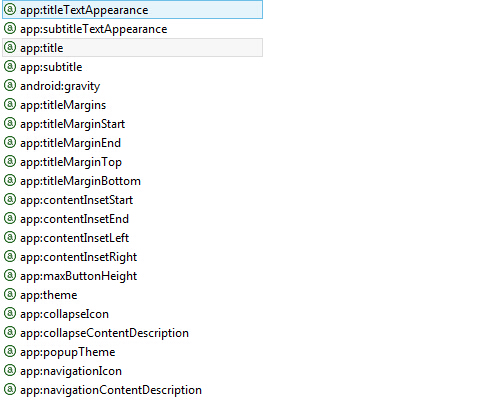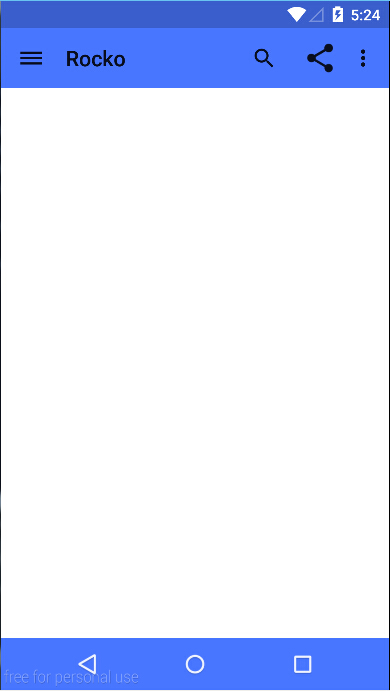标签:
Toolbar
Toolbar是什么?大概说一下它的官方介绍。Toolbar是应用的内容的标准工具栏,可以说是Actionbar的升级版,两者不是独立关系,要使用Toolbar还是得跟ActionBar扯上关系的。相比Actionbar Toolbar最明显的一点就是变得很自由,可随处放置,因为它是作为一个ViewGroup来定义使用的,所以单纯使用ActionBar已经稍显过时了,它的一些方法已被标注过时。
那么它怎么使用呢,首先我们一样要用到v7的支持包,然后定义程序的主题样式,在style里得先把Actionbar去掉,有点像欲想练功,必先自宫的感觉啊。如下:
/res/values/styles.xml
<resources xmlns:android="http://schemas.android.com/apk/res/android"> <style name="AppBaseTheme" parent="Theme.AppCompat.Light.NoActionBar"> <!-- toolbar(actionbar)颜色 --> <item name="colorPrimary">#4876FF</item> <!-- 状态栏颜色 --> <item name="colorPrimaryDark">#3A5FCD</item> <!-- 窗口的背景颜色 --> <item name="android:windowBackground">@android:color/white</item> <!-- SearchView --> <item name="searchViewStyle">@style/MySearchViewStyle</item> </style> <style name="AppTheme" parent="@style/AppBaseTheme"></style> <style name="MySearchViewStyle" parent="Widget.AppCompat.SearchView"> <!-- Background for the search query section (e.g. EditText) <item name="queryBackground">...</item> Background for the actions section (e.g. voice, submit) <item name="submitBackground">...</item> Close button icon <item name="closeIcon">...</item> Search button icon <item name="searchIcon">...</item> Go/commit button icon <item name="goIcon">...</item> Voice search button icon <item name="voiceIcon">...</item> Commit icon shown in the query suggestion row <item name="commitIcon">...</item> Layout for query suggestion rows <item name="suggestionRowLayout">...</item> --> </style> </resources>
去除Actionbar最简单的方法就是直接继承NoActionBar的主题了。颜色的属性说明,还是下面这张图最清楚了:

另外,SearchView在AppCompat中提供了更强的可定制性和更多的样式可供设置,不过一般我们用默认的就行。
还有我们可以在values-v21给API21的系统版本设置默认的底部导航栏默认的颜色:
/res/values-v21/styles.xml
<resources xmlns:android="http://schemas.android.com/apk/res/android"> <style name="AppTheme" parent="@style/AppBaseTheme"> <!-- 底部导航栏颜色 --> <item name="android:navigationBarColor">#4876FF</item> </style> </resources>
设置好主题的下一步工作:
在xml的layout中定义一个Toolbar:
/layout/toolbar.xml
<?xml version="1.0" encoding="utf-8"?> <android.support.v7.widget.Toolbar xmlns:android="http://schemas.android.com/apk/res/android" xmlns:app="http://schemas.android.com/apk/res/com.example.toolbar" android:id="@+id/toolbar" android:layout_width="match_parent" android:layout_height="wrap_content" android:background="?attr/colorPrimary" android:minHeight="?attr/actionBarSize" app:popupTheme="@style/ThemeOverlay.AppCompat.Light" app:theme="@style/ThemeOverlay.AppCompat.ActionBar" > </android.support.v7.widget.Toolbar>
我们把toolbar作为一个独立的布局xml,方便在其他布局里include进去。可以看到我们在这里是可以设置Toolbar的属性的,初上面的外还有以下的属性,都是见名知意的就不一一说明了。

然后在activity的布局里把它include进去就行了,当然一般把它放到最上面了,有需要你是可以把它放到中间、底部或其它位置的,可见它的自由度是很高的。在下一步呢就到代码了,在onCreate中:
mToolbar = (Toolbar) findViewById(R.id.toolbar);
// toolbar.setLogo(R.drawable.ic_launcher);
mToolbar.setTitle("Rocko");// 标题的文字需在setSupportActionBar之前,不然会无效
// toolbar.setSubtitle("副标题");
setSupportActionBar(mToolbar);
/* 这些通过ActionBar来设置也是一样的,注意要在setSupportActionBar(toolbar);之后,不然就报错了 */
// getSupportActionBar().setTitle("标题");
// getSupportActionBar().setSubtitle("副标题");
// getSupportActionBar().setLogo(R.drawable.ic_launcher);
/* 菜单的监听可以在toolbar里设置,也可以像ActionBar那样,通过Activity的onOptionsItemSelected回调方法来处理 */
mToolbar.setOnMenuItemClickListener(new Toolbar.OnMenuItemClickListener() {
@Override
public boolean onMenuItemClick(MenuItem item) {
switch (item.getItemId()) {
case R.id.action_settings:
Toast.makeText(MainActivity.this, "action_settings", 0).show();
break;
case R.id.action_share:
Toast.makeText(MainActivity.this, "action_share", 0).show();
break;
default:
break;
}
return true;
}
});
上面关键的一点就是setSupportActionBar(mToolbar);把Toolbar当做ActionBar给设置了。menu还是可以像ActionBar一样用和处理的:
res/menu/main.xml
<menu xmlns:android="http://schemas.android.com/apk/res/android" xmlns:app="http://schemas.android.com/apk/res-auto" xmlns:tools="http://schemas.android.com/tools" tools:context=".MainActivity" > <item android:id="@+id/ab_search" android:orderInCategory="80" android:title="action_search" app:actionViewClass="android.support.v7.widget.SearchView" app:showAsAction="ifRoom"/> <item android:id="@+id/action_share" android:orderInCategory="90" android:title="action_share" app:actionProviderClass="android.support.v7.widget.ShareActionProvider" app:showAsAction="ifRoom"/> <item android:id="@+id/action_settings" android:orderInCategory="100" android:title="action_settings" app:showAsAction="never"/> </menu>
这一步时候程序的样子: PS. Genymotion可以用5.0的模拟器了
PS. Genymotion可以用5.0的模拟器了
可以感觉到这样是不是和ActionBar没什么区别呢。诶,左边的菜单图标怎么出来的呢,其实上面还没处理到,他就是Navigation drawer了,使用新版本的v4、v7库的drawer明显的一点是它带了一个酷酷的交互动画(请看最后的gif图)。那么使用Toolbar之后又怎么去在Toolbar中使用drawer呢。下面当然也是跟着代码来.
/layout/activity_main.xml
<LinearLayout xmlns:android="http://schemas.android.com/apk/res/android" xmlns:tools="http://schemas.android.com/tools" android:layout_width="match_parent" android:layout_height="match_parent" android:orientation="vertical" tools:context="com.example.toolbar.MainActivity" > <include layout="@layout/toolbar" /> <android.support.v4.widget.DrawerLayout android:id="@+id/drawer" android:layout_width="match_parent" android:layout_height="match_parent" > <!-- 内容界面 --> <LinearLayout android:layout_width="match_parent" android:layout_height="match_parent" android:orientation="vertical" > <com.example.toolbar.widget.PagerSlidingTabStrip android:id="@+id/tabs" android:layout_width="match_parent" android:layout_height="48dip" > </com.example.toolbar.widget.PagerSlidingTabStrip> <android.support.v4.view.ViewPager android:id="@+id/pager" android:layout_width="match_parent" android:layout_height="match_parent" > </android.support.v4.view.ViewPager> </LinearLayout> <!-- 侧滑菜单内容 --> <LinearLayout android:id="@+id/drawer_view" android:layout_width="match_parent" android:layout_height="match_parent" android:layout_gravity="start" android:background="@drawable/drawer" android:orientation="vertical" android:padding="8dp" > <TextView android:layout_width="match_parent" android:layout_height="match_parent" /> </LinearLayout> </android.support.v4.widget.DrawerLayout> </LinearLayout>
Pager的东西可以先忽略,后面会说到。侧滑菜单的内容为简单起见直接先用图片来演示了。可以看到布局的设置大同小异,不同点在代码中:
getSupportActionBar().setDisplayHomeAsUpEnabled(true); mDrawerLayout = (DrawerLayout) findViewById(R.id.drawer); mDrawerToggle = new ActionBarDrawerToggle(this, mDrawerLayout, mToolbar, R.string.drawer_open, R.string.drawer_close); mDrawerToggle.syncState(); mDrawerLayout.setDrawerListener(mDrawerToggle);
先把图标设置显示出来,然后把ActionBarDrawerToggle作为DrawerLayout的监听器设置进去,还是比较简单的,效果:

要是需要把drawer覆盖toolbar怎么办呢?需要稍微调整一下界面的布局位置就行了,效果就不贴上来了(脑补,或者改下源码的setContentView运行):
<android.support.v4.widget.DrawerLayout xmlns:android="http://schemas.android.com/apk/res/android" xmlns:tools="http://schemas.android.com/tools" android:id="@+id/drawer" android:layout_width="match_parent" android:layout_height="match_parent" android:fitsSystemWindows="true" > <LinearLayout android:layout_width="match_parent" android:layout_height="match_parent" android:orientation="vertical" tools:context="com.example.toolbar.MainActivity" > <include layout="@layout/toolbar" /> <!-- 内容界面 --> <LinearLayout android:layout_width="match_parent" android:layout_height="match_parent" android:background="@drawable/content" android:orientation="vertical" > <com.example.toolbar.widget.PagerSlidingTabStrip android:id="@+id/tabs" android:layout_width="match_parent" android:layout_height="48dip" android:visibility="invisible" > </com.example.toolbar.widget.PagerSlidingTabStrip> <android.support.v4.view.ViewPager android:id="@+id/pager" android:layout_width="match_parent" android:layout_height="match_parent" android:visibility="invisible" > </android.support.v4.view.ViewPager> </LinearLayout> </LinearLayout> <!-- 侧滑菜单内容 --> <LinearLayout android:id="@+id/drawer_view" android:layout_width="match_parent" android:layout_height="match_parent" android:layout_gravity="start" android:background="@drawable/drawer" android:orientation="vertical" android:clickable="true" android:padding="8dp" > <TextView android:layout_width="match_parent" android:layout_height="match_parent" /> </LinearLayout> </android.support.v4.widget.DrawerLayout>
Demo源码下载地址:http://download.csdn.net/detail/bbld_/8191251
依赖库android-support-v7-appcompat.rar with Palette : http://download.csdn.net/detail/bbld_/8382913
标签:
原文地址:http://my.oschina.net/kooeasy/blog/484712